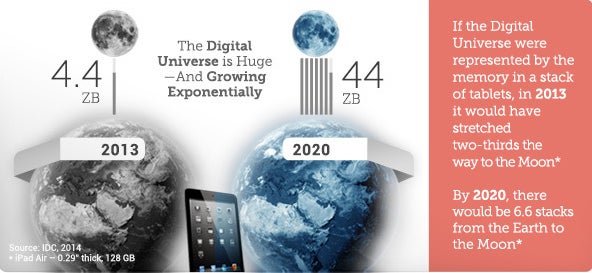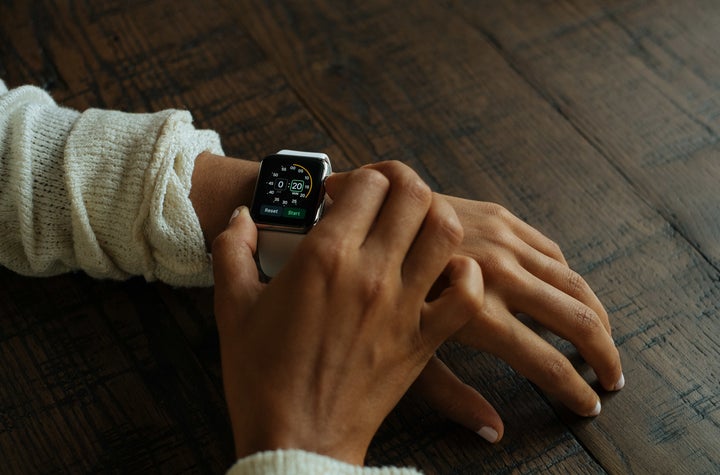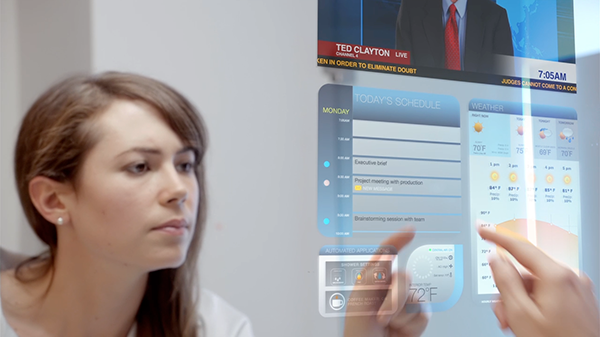In early 2011, glass manufacturer Corning released a video that took our imaginations to new heights. Since then, ‘A Day Made of Glass’ has amassed more than 25 million views on YouTube and given the world a glimpse into a future powered by data, manifested on a glass surface.
What’s even more compelling than the storyline, soothing melodic undertones and aesthetically pleasing design is the not-so-distant feasibility of this technology and the powerful potential it holds for the customer experience.
By 2020, there will be nearly as many digital bits in the world as there are stars in the universe. Roughly 1.7 megabytes of information will be created each second for every human on the planet and wireless device traffic will account for two-thirds of total IP traffic.

Data will be at the heart of how we communicate, engage, interact and thrive in this hyper-connected world. Corning’s “Jetson-esque” representation of the future was meant to inspire investors, but in parallel, ignited the curiosity of millions of viewers who can envision waking up in a world fueled by intelligent technology.
To know where we’re going, we first have to understand where we’ve been. Let’s take a walk through the transformation of customer intelligence and what the future holds.
The Evolution of Customer Intelligence

The radio and television equip marketers with reach
AT&T is credited for funding the first radio commercial that broadcasted across public airwaves 94 years ago for a whopping $50 USD. The fifty-minute program promoted the sale of apartments in Jackson Heights and kicked off a craze for consumers and brands alike. While newspapers provided an outlet for brands to reach a mass audience, it was the advent of the radio that enabled marketers to reach an audience during a specific time of day.
Imagine the customer experience for the listeners of early radio. Families gathered around their radios after dinner, eagerly awaiting a sponsored public service program to play. Suddenly, a quirky commercial for Tempo Cigarettes chimes into your living room, getting your kids off the floor to dance along with a jingle promoting a flavorful tobacco rush.
The information brands had about their customers at that time was virtually nonexistent. The original Nielsen ratings only provided estimates for how many people were listening within each household.
Brands were casting a wide net, tossing money into a frequency pool in hopes of catching the ears of potential buyers.
It wasn’t until the late 1950s, with the widespread introduction of television, that the Nielsen ratings revealed audience data such as age, race, gender and location. Suddenly, marketers could target specific demographic segments and estimate results based on revenue lift. They now had some insight, however small, into who their customers were paired with the technology to communicate with them.
Direct mail and the internet enable targeting at scale

In the 1960s, the concept of customer-centric marketing first appeared on the scene. Credited to advertising guru Lester Wunderman, the direct marketing revolution began. This paradigm shift in marketing pivoted the focus from casting the widest net possible to targeting individual consumers with the most meaningful and relevant marketing possible. This is, arguably, the birth of customer intelligence. It was at this time that brands began using customer data to make better-informed decisions.
Throughout the 1980s, channels like direct mail and innovations such as loyalty programs at brick-and-mortar stores enabled marketers to begin measuring the behavior of individual customers and reaching out with targeted messaging and promotions. Then, as internet usage flourished in the late 1990s and e-commerce sites grew in popularity, transactional and location data became accessible to layer that targeting with greater depth and context.
Connected devices deliver real-time intelligence

We’ve come a long way since the proliferation of the internet. By 2020, there will be more than 50 billion smart connected devices in the world, all designed to collect, analyze and distribute data.
Customers with Amazon Dash can push a button when they run out of Red Bull and a fresh supply arrives within 24 hours at their front door. Samsung’s smart fridge tells you what groceries are stocked at any time and allows you to refill directly from the refrigerator touchscreen. The autonomous desk reminds you to stand up when you’ve been sitting for too long, orders lunch when your stomach starts grumbling and calls an Uber when it’s time to go home.
We live in an always-on, hyper-connected, intelligently designed world of personalization and customization. At the center of it all, lies data. It is interwoven in the fabric between us and our ability to connect with the world. The future of which is predictable analytics.
“The most powerful data you have is something you are sitting on that nobody else has.” - Martin Kihn, Gartner Research Director
Intelligently Predictive Analytics

Why do I have to press a button to order more Red Bull? Why do I have to click the refrigerator touchscreen to restock my milk? If Amazon knows my habits, purchase history and the amount of Red Bull I consume on average throughout the course of a week - shouldn’t they also know when to order more? If the smart fridge knows when I’m out of milk, shouldn’t it know to place an order automatically? Why do I have to ask my desk to order an Uber for me if it knows that I need one at 6:00 pm every day?
If your connected devices aren’t doing this yet, they will soon. At Woopra, we believe that predictive analytics is the future of customer intelligence. While some companies are treading lightly in this space, the potential it holds remains a relatively untapped arena. We will be able to proactively anticipate a customer’s next move, combining real-time intelligence, behavioral analytics, machine learning and predictive modeling with automated actions.
Imagine waking up in a world similar to that in the Day Made of Glass video. Spotify plays your favorite morning tunes as the alarm sounds in the morning. A pumpkin spice latte arrives fresh and hot at your doorstep via the Starbucks drone. Your self-driving car takes a pit stop at an electronic fueling station and reroutes to accommodate traffic conditions. The morning conference call takes place on a smart-display glass wall, recognizing as you walk into the room and seamlessly transferring a presentation from your tablet to the glass display.
All of this, and more, will be possible not just in our lifetime, but over the course of the next ten years. We will live in a world made of data. It will change how we work, communicate, interact and live. For marketers, we will be able to execute faster, personalize greater and liberate the curiosity of our teams to forever change the way we innovate.
